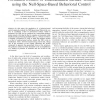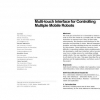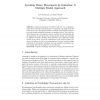52 search results - page 2 / 11 » Neural Fields for Controlling Formation of Multiple Robots |
IROS
2006
IEEE
13 years 11 months ago
2006
IEEE
— In this paper the application of a behavior-based control approach, namely the Null-Space-based Behavioral control, to coordinate a fleet of autonomous surface vessels is pres...
TROB
2002
13 years 5 months ago
2002
Abstract-We study the problem of achieving global behavior in a group of distributed robots using only local sensing and minimal communication, in the context of formations. The go...
CHI
2009
ACM
14 years 5 months ago
2009
ACM
We must give some form of a command to robots in order to have the robots do a complex task. An initial instruction is required even if they do their tasks autonomously. We theref...
TROB
2002
13 years 5 months ago
2002
This paper describes how decentralized control theory can be used to analyze the control of multiple cooperative robotic vehicles. Models of cooperation are discussed and related t...
KI
2008
Springer
13 years 5 months ago
2008
Springer
Abstract. Imitation learning is an intuitive and easy way of programming robots. Instead of specifying motor commands, you simply show the robot what to do. This paper presents a m...



